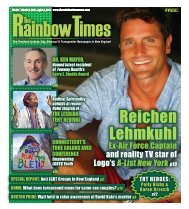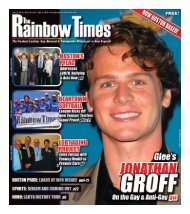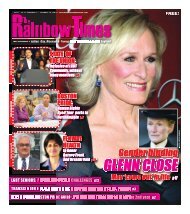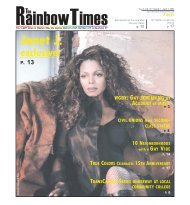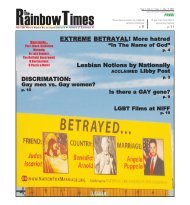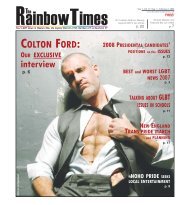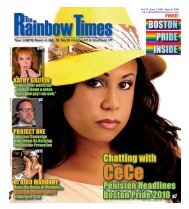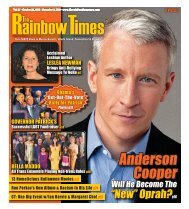Toni Braxton's - The Rainbow Times
Toni Braxton's - The Rainbow Times
Toni Braxton's - The Rainbow Times
Create successful ePaper yourself
Turn your PDF publications into a flip-book with our unique Google optimized e-Paper software.
By: Andrew Collins*Visitation at America’s best-known nationalparks has skyrocketed in recent years, so it’sno surprise that these monuments to naturalscenery and wide-open spaces have becomeincreasingly popular with gays and lesbians.Whether you’re into camping, serious hikingand off-road trekking, or you’re more likely tostay in a romantic lodge, check out the parkmuseums and spend most of your time in yourcar, you’ll be happy to know that most nationalparks offer a balance of both mellow and rigorousdiversions.<strong>The</strong> southwestern United States, from thesweeping deserts of interior Southern Californiato the spectacular rock formations, deepcanyons and craggy cliffs of Arizona andUtah, contains several of the nation’s most celebratednational parks. Here’s a look at someof the most impressive.Death Valley National Park, California(www.nps.gov/deva)Covering an astounding 5,200 square miles(making it just slightly smaller than the stateof Connecticut), Death Valley National Parkis immense in scope - it contains the lowestpoint in the United States, Badwater Basin,a salty, mud-caked spot that you can walk toeasily from the road. And it claims the hottestsummer temperatures in the country (late fallthrough early spring are mild and comfortable,however). But the park’s extreme aspectssometimes take away from the tremendousdiversity of its terrain, from the cooler highmountains peaks (some with elevations above10,000 feet) that overlook the valley to the undulatingsand dunes near Stovepipe Wells.You could explore Death Valley for a fullweek and nevercome close to seeingall of the park’snotable sites - theremains of historicborax works, hikesthrough the dramaticallycoloredrock formations ofMosaic Canyon,costumed toursof the remote andeccentric 1920smansion knownas Scotty’s Castle.This is one park,because of itsenormity, where itcan be very helpful to book a guided excursion- Pink Jeep Tours offers informative tripsaround the park in modern, comfortable, fullyenclosed vehicles.Grand Canyon National Park, Arizona(www.nps.gov/grca)It’s fair to say that enough has been writtenand said about the Grand Canyon that evenwww.therainbowtimesnews.com • <strong>The</strong> <strong>Rainbow</strong> <strong>Times</strong> • May 6, 2010 - May 19, 2010 • 19Research Reveals both the Strengths and Challenges of Gay and Lesbian FamiliesBy: Tynan Power/TRT ReporterWhen she was working on her Ph.D. in ClinicalPsychology at UMass Amherst, Dr. Abbie Goldbergwas surprised to discover there was verylittle research about gay and lesbian experiencesof the transition to parenthood.“<strong>The</strong>re are hundreds and hundreds of articlesabout heterosexual parents,” Goldberg says. Atthe time, though, there were virtually none aboutsame-sex parents. Since then, Goldberg’s researchhas helped fill that void.Now a professor ofpsychology at ClarkUniversity and authorof Lesbian andgay parents and theirchildren: Research onthe family life cycle,Goldberg returnedto the area to presentabout her work atSpringfield TechnicalCommunity College,STCC, on April 27.To mark the event,Dominic Sarno, Photo: Abbie GoldbergMayor of Springfield, Dr. Abbie Goldbergissued a proclamationnaming Thursday, April 27, 2010, “Dr. AbbieGoldberg Day” in honor of her work.“I was drawn to something that was understudiedand had potential benefit for people’s lives,”Goldberg says of her research on gay and lesbianfamilies.She knew that studies showed that the transitionto parenthood is both exciting and stressful.Research had documented that new parents sufferfrom lack of sleep, have less time for their relationshipas a couple and have virtually no personaltime for themselves. Women, in particular,have less time for themselves as they tend to takeon more childcare and household responsibilities.Yet all these studies applied exclusively to heterosexualcouples.Goldberg has found there is plenty of interestin her work, as her numerous publications andcollaborations attest. Her research has even beenused in a California court case challenging Proposition8, which prohibits gay marriage. <strong>The</strong> timingof her research couldn’t be better, as focus on gayand lesbian families has increased dramatically inrecent years.“Gay parents are increasingly choosing to beout,” Goldberg says.<strong>The</strong>re are also simply more gay and lesbianparents.“In 1990, 1 in 20 gay couples and 1 in 5 lesbiancouples were raising children. By 2000, 1 in 5 gaycouples and 1 in 3 lesbian couples had children,”Goldberg explains.According to Goldberg, there are three primaryways that gay and lesbian couples becomeparents: through previous heterosexual relationships,through insemination and through adoptiveor foster parenting. Once they become parents,Goldberg’s research suggests that gay andlesbian parents experience a similar transition toparenthood.“Everybody is stressed out,” Goldberg says ofthe early stage of parenting. “New gay, lesbianand straight parents all show a mild decline inmental health.”Mental health figures improvewhen parents have the support offamily and friends, when couplesare satisfied with their relationshipand when they start parenting witha younger child.Similarly, studies show that gayand lesbian parents share important traits withheterosexual parents.“As parents, they are just as skilled, just as warmand involved. <strong>The</strong>y are just as committed. <strong>The</strong>ylove their children just as much,” Goldberg says.She adds that they have similar mental health andsimilar levels of happiness in their relationships,with lesbian couples reporting the highest relationshipsatisfaction rate of all couples studied.<strong>The</strong> children of gay and lesbian couples are alsosimilar to children raised by heterosexual parents,according to Goldberg. She says children fromgay, lesbian and heterosexual families have similaroverall well-being, social skills, cognitiveabilities, and family function.<strong>The</strong>re are also some important differencesin the experiences of gay and lesbianfamilies.For example, factors that contribute towell-being for gay and lesbian couplesmay not matter to heterosexual couples.Living in a gay-friendly neighborhoodand in a state with laws that support adoptionby same-sex couples are factors thathave a positive impact on the transition toparenthood for gay and lesbian couples,Goldberg says. Another is having a gayfriendlyemployer.<strong>The</strong>re are other differences in gay andlesbian families, as well.“Lesbian and gay couples share childcareand housework more equally,”Goldberg says. She says same-sex couplesdon’t fall into traditional divisions of labor.“Traditional gender roles go out the window.”However, that’s not the only reason Goldberghas found for more equitable divisions of labor.“Gay and lesbian couples value equality in their“Being gay itself is not the problem forparents or their children,” Goldbergsays. “Institutionalized heterosexism is.”relationships more than heterosexual couples do,”Goldberg says.Gay and lesbian couples do face unique challenges,according to Goldberg. For example, theymay have less support from family, initially, butsome report that support increases after childrenenter the picture.“A cute little baby is really different from theidea of a possible child,” Goldberg says.<strong>The</strong> children of gays and lesbians do have someexperiences that differ from those of their peerswith straight parents. While they are not morelikely to be teased, according to Goldberg, teasingthose who’ve never been often feel they havea good sense of it. Still, it’s nearly impossibleto comprehend the full splendor of this massivechasm that’s 18 miles across, 300 mileslong, and over a mile deep - it must be seen tobe believed.A surprisingnumber of visitorscome by fora day, stop by afew viewpoints,and continue on. Ifat all possible, tryto spend at leasta couple of dayshere. <strong>The</strong> SouthRim is the mostaccessible thanits higher-altitudecounterpart, theNorth Rim (whichis also closed inwinter). On anideal visit to theSouth Rim, you’ll stay at one of the severallodging options inside the park (book manymonths in advance if you’re planning a summervisit), hike at least part of the way into thecanyon, and ride the park shuttle bus along therim, stopping at the many noteworthy viewingareas. If you have extra time, consider ridingthe scenic Grand Canyon Railway from thetown of Williams, about 60 miles south.Photo: tynan powerMyra Smith, STCC Vice President of Human Resourcesand Multicultural Affairs at STCC, Dr. Abbie Goldberg,and Ira H. Rubenzahl, STCC Presidentthat does occur is more likely to be about theirfamilies or sexuality.Children of gays and lesbians are more sensitiveto homophobia, according to Goldberg. Thisawareness may lead them to activism. Others mayhide their families to avoid having to come outrepeatedly to people who simplyassume that all kids have straightparents.“<strong>The</strong>y tend to be more tolerantof differences and have more empathyfor other stigmatized minoritygroups,” she says. <strong>The</strong>y alsomay be more flexible about genderroles, such as in career aspirations and hobbies.Ultimately, Goldberg says, gay and lesbian parentsand their children are developing well.“Being gay itself is not the problem for parentsor their children,” Goldberg says. “Institutionalizedheterosexism is.”More information about Dr. Abbie Goldberg’swork can be found at: http://www.clarku.edu/faculty/goldberg. One current projects seeksparticipants who are adopting for the first time;another is open to youth aged 14-26 who havegay, lesbian or bisexual parents.Out of Town: A glimpse at some of the beautiful National Parks of the SouthwestPhoto: Andrew CollinsMosaic Canyon, in Death Valley National ParkJoshua Tree National Park, California(www.nps.gov/jotr)A short drive from the world-famous gayresort Palm Springs, this 800,000-acre park atthe convergence of the deathly hot Coloradoand slightly cooler Mojave deserts feels milesaway from civilization. It looks almost lunarlike in places. Of course, it’s famous for thethousands of curious-looking Joshua trees forwhich the park is named. <strong>The</strong>se distinctivemembers of the lily family grow about an incha year and bloom winsome white flowers everso rarely.This aside, seeing a Joshua tree is but aminor reason to visit. <strong>The</strong>re are several scenicdrives - the 6-mile spur out to 5,100-footKeys View affords breathtaking vistas overthe entire Coachella Valley. Several shortbut fascinating trails penetrate the park’smyriad ecosystems: a brief scramble throughthe Cholla Cactus Garden will introduce youto the regional flora, while the 1.3-mile HighView Nature Trail entails a 300-foot ascent tomagnificent Summit Peak. Longer trails pastpiles of massive boulders and by oasis like hotsprings offer the possibility of spying bighornsheep and golden eagles.*Andrew Collins covers gay travel for theNew York <strong>Times</strong>-owned website About.comand is the author of Fodor’s Gay Guide to theUSA. He can be reached care of this publicationor at OutofTown@qsyndicate.com.





